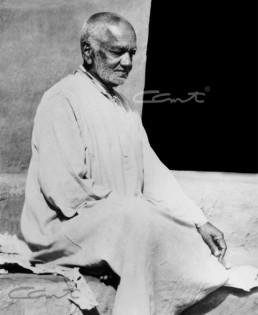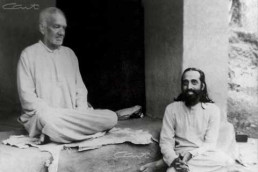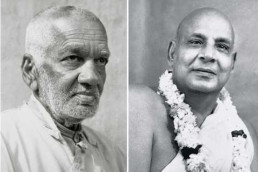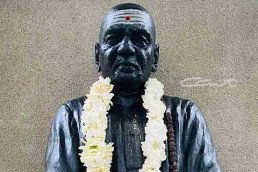
One Goal - Many Paths
This article is a translation from the original manuscript in Malayalam. We thank Smt. Leela Nambiar for giving us permission to access the document and publish it. Our special thanks to Acharya Atma Chaitanya who translated it into English with great care and reverence. We are beholden to Dr. Chidambaram and Dr. Mrs. Kamala Chidambaram for their invaluable help in fine-tuning and editing the translation. The title and the sub-headings have been added by us.
The manuscript makes it clear that it is a commentary on specific slokas. Though the page numbers and sloka numbers are cited (given in the footnotes here), the text is not mentioned. In spite of our best efforts, we have not been able to find out the actual Slokas nor the text where they occur. So, we leave it to the readers to solve this puzzle. We will be very grateful if someone is able to find out and let us know which text is the source for this commentary.

One Goal - Many Paths
This article is a translation from the original manuscript in Malayalam. We thank Smt. Leela Nambiar for giving us permission to access the document and publish it. Our special thanks to Acharya Atma Chaitanya who translated it into English with great care and reverence. We are beholden to Dr. Chidambaram and Dr. Mrs. Kamala Chidambaram for their invaluable help in fine-tuning and editing the translation. The title and the sub-headings have been added by us.
The manuscript makes it clear that it is a commentary on specific slokas. Though the page numbers and sloka numbers are cited (given in the footnotes here), the text is not mentioned. In spite of our best efforts, we have not been able to find out the actual Slokas nor the text where they occur. So, we leave it to the readers to solve this puzzle. We will be very grateful if someone is able to find out and let us know which text is the source for this commentary.
The absolute Truth is only one and not two. In that Reality, there cannot be divisions like sajātiya bheda (differences in the same species), vijātiya bheda (differences between two or more species) and svagata bheda (differences in one given entity). Two independent entities cannot coexist.1 In the world too it is not seen like that. Pot and cloth are not two independent objects. Pot has no domination upon the cloth; similarly, cloth has no domination upon the pot.2 Therefore, these two are dependent as well. Dependent objects are limited by time and space and hence they are perishable. If two entities are accepted to be Real, they cannot have the nature of freedom, existence and imperishability. It is illogical that two entities can both be perishable and also have absolute Reality. Therefore, there cannot be another entity equivalent to the Truth. Hence, it is clear that there can be only one homogenous (akhanda) Reality and it is not compatible with duality. How can a dependent object conditioned by another object be eternal? Thus the Upanishads and the Mahatmas declare that the absolute Truth is non-dual, homogenous and one essence (eka-rasam) which is called Paramātmā (supreme Self) and Isvara (the Lord).
The same Paramātmā assumes forms befitting the temperaments of the devotees, as Vishnu, Krishna, Rama, Siva and Goddess Sakti. The same supreme Self, which is all-pervading and a mass of Existence, Knowledge and Bliss is limited by ignorance and the products of ignorance such as subtle bodies and gross bodies, that is, identifying with them, takes on the jīva-bhāva (of a limited ego). The Vedas declare that this flow of jīva, īśvara and jagat is beginningless and endless. If Brahman and the power of Brahman called mahāmāyā is without beginning and end, its effects as jīva-īśvara-jagat also continue to flow without beginning or end.3
Dropping Our False Identity
The sense of ‘I’ in the body is well-known in Vedanta as ‘superimposition’. Identifying with the body made of flesh and bone, and because of that suffering all kinds of endless miseries, the deluded jīva never gains peace in this world. As long as this very strong delusion of the sense of ‘I’ in the body and the sense of ‘mine’ in those related to the body as wife, children and wealth etc. exist, so long this saṁsāra of the cycle of birth and death will not end.
In order to remove the sense of ‘I’ in the body and the consequent manifold worldly tragedies and to attain the state of supreme bliss, one has to cultivate the sense of ‘I’ in the Self which is one’s own real nature and get established in the knowledge of the Self. The Self has no connection with the body, nor with anything related to the body. Knowing the unattached and changeless Self and revelling in it is mokşa. That alone is the supreme goal parama-puruşārtham.4
The Path of Selfless Action
In order to accomplish the supreme goal which fulfils human birth, the scriptures primarily advise selfless activities and the path of devotion. The householders, in particular, must practise the dedicated performance of self-less action with passionate involvement. Whatever may be the activity, secular or sacred, if performed as worship of the Lord in accordance with one’s capacity, it is known as selfless action – nişkäma-karmam. Selfish actions performed with desire for fruits of action become tainted with desires and lead to saṁsāra (the cycle of births and deaths). Therefore, relinquishing desires completely, with the firm conviction that action is for the sake of action alone, all appropriate actions (according to one’s dharma) should be performed as worship at the feet of the Lord. Thus, when we practice, the mind is gradually relieved of likes, dislikes etc. and becoming free of the thirst for enjoyment, attains purity.5
The Path of Devotion
Among the means for attaining the Lord, the path of devotion is very easy. Continual, constant, intense love of God is called devotion. Even those who are not blessed with great intellectual power and those who are incapable of practising intense spiritual disciplines can also pursue the path of devotion. Love for sense objects needs to be turned towards the Lord alone. To the ordinary seekers desiring attainment of the feet of the Lord, the path of devotion is the best. They should begin to practise devotional exercises. If one can have the same kind of intensity in loving the all-compassionate Lord as worldly people have towards their wife and children – once such intense devotion has risen – then what else is there to be gained in this world? Having practised the means of devotion through actions like japa, singing His glory, listening, meditation etc. for a long time, when firm devotion rises in the mind, it leads to direct realisation of God. A devotee can realise the Lord either with form or without any form.6
The Path of Aștānga Yoga
Prāņāyāma and practice of yoga exercises is also one of the means for God-realisation. Since it is not possible to realise the essence of Brahman without purity and control of mind, need it be mentioned separately that the practice of yoga, which is a form of mental restraint, is very useful for the realisation of God? One should practise the paths suited to one’s nature. With the control of prāna, mental restraint can be achieved gradually. Without the practice of yama, niyama, viveka and vairāgya, mere practice of prāņāyāma and some āsanas will not help in gaining liberation or realising the truth about the Lord. All these bodily exercises are only like the physical exercises of school students, but they will not help to attain the Self, much less gain the restraint of mind which is the means for Realisation. Therefore the eight steps in yoga (asțänga) have to be sequentially practised to attain mastery. Without these, the pūraka and kumbhaka of fools who are desirous of worldly pleasures and devoid of the desire for liberation become a matter for laughter and mockery. Those yogis should be known as brothers of fishermen who also do kumbhaka (control of the breath) while diving to catch fish. Prāņāyāma without yama and niyama is a waste.
Conclusion
Thus each one, according to his innate nature, has to pursue firmly one of the paths – selfless activities, devotion or yoga. This will help to cleanse the mind and make it pure and single-pointed, rendering it capable of contemplating on the changeless Brahman and realising it. Thereafter, through analysis of the essence of Truth, it is possible to attain the vision of the Truth easily. Realisation of the Truth is not far away for the mind thus qualified by pursuing these practices. Therefore, one has to continue efforts for a long time with great enthusiasm in karma yoga, bhakti and yoga. In this way, the mind having become pure and single-pointed, one realises the formless, attributeless, transcendental Truth and attains the state of kaivalya.7
1 An independent entity here refers to an entity which is not limited or conditioned by other entities.
2 The word ‘domination’ here seems to refer to pervasiveness. The pot does not pervade the cloth. In fact, it is limited by the very existence of the cloth. So also with the cloth which is limited by the existence of the pot.
3 Page 317, Slokas 8, 9 and 10
4 Page 318, Slokas 11 and 12
5 Page 331, sloka 74
6 Page 333, slokas 83 & 84
7 Page 337, slokas 101 & 102
Previous Topic
Reminiscences
In this article Pujya Gurudev fondly shares some memories of his Guru, Swami Tapovan Maharaj. This article was published in…
Next Topic
Real Bhava in Service
In this article Pujya Gurudev fondly shares some memories of his Guru, Swami Tapovan Maharaj. This article was published in…
Home Page
Homage to Sri Swami Tapovanam
The 50th anniversary edition of Tapovan Prasad (December 2011) was entirely dedicated to our Paramaguru Swami Tapovan…


